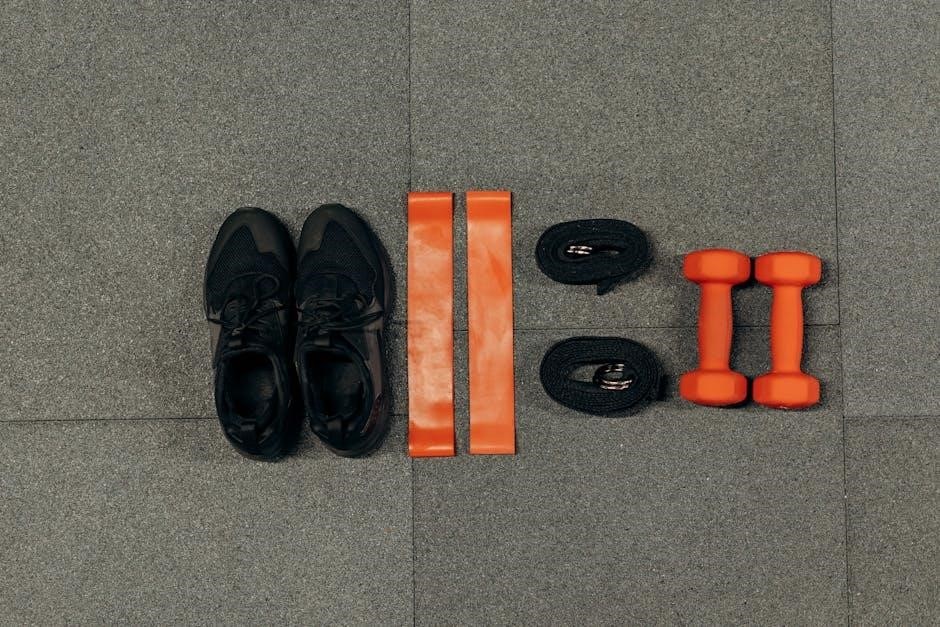The 800m requires a blend of speed, endurance, and strategy. A well-structured training plan helps athletes set realistic goals, enhance performance, and achieve success in races.
1.1 Understanding the 800m Event
The 800m is a middle-distance race requiring a unique blend of speed, endurance, and tactical awareness. It demands sustained effort over two laps, making pacing and stamina crucial. The event is highly tactical, with athletes needing to position themselves strategically while maintaining optimal speed. Understanding the physical and mental demands of the 800m is essential for designing an effective training plan tailored to individual needs and goals.
1.2 Importance of a Structured Training Plan
A structured training plan is crucial for 800m success, ensuring balanced development of speed, endurance, and race tactics. It helps athletes avoid overtraining, prevents injuries, and optimizes progress. By organizing workouts systematically, runners can build strength, improve pacing, and enhance mental resilience. A well-designed plan also allows for consistent improvement, ensuring peak performance on race day. Tailored to individual needs, it guides athletes through specific phases, fostering confidence and readiness for competition.

Types of 800m Runners
800m runners are categorized into two main types: Type I, who excel in high-speed endurance, and Type II, who specialize in middle-distance performance, balancing speed and stamina.
2.1 Type I Athlete: High-Speed Endurance
Type I athletes are characterized by their exceptional speed and endurance. They typically excel in shorter sprints like the 400m or 200m, bringing a strong foundation to the 800m. Their training focuses on maintaining high speeds over longer distances, enhancing lactate threshold, and improving race tactics. This type of runner benefits from interval workouts, tempo runs, and strength training to build both speed and stamina for the demands of the 800m event.
2.2 Type II Athlete: Middle-Distance Specialist
Type II athletes are middle-distance specialists who excel in endurance and aerobic capacity. They may lack top-end speed but compensate with strong stamina and race tactics. Their training emphasizes building lactate threshold and increasing mileage to enhance endurance. These athletes thrive in longer intervals, tempo runs, and consistent pacing workouts, making them well-suited for the 800m event, where sustained effort and strategic racing are crucial for success.

Setting Realistic Goals
Setting realistic goals involves assessing current fitness levels and setting achievable target times, such as 1:59 or 2:19, to create a structured training plan.
3.1 Assessing Current Fitness Levels
Evaluating your current fitness is crucial for creating an effective 800m training plan. Start by assessing your 400m and 800m personal best times, as well as your maximal aerobic capacity. Perform a time trial or prognostic run to gauge your endurance and speed. Additionally, consider your training history and weekly mileage to determine your starting point. This baseline assessment ensures your goals are realistic and tailored to your abilities, helping you progress safely and efficiently towards your target times, such as 1:59 or 2:19.
3.2 Setting Target Times (e.g., 1:59 or 2:19)
Setting realistic target times is essential for guiding your 800m training plan. For example, aiming for a 1:59 or 2:19 finish line requires understanding your current fitness and race potential. Use recent race performances or time trials to establish achievable goals. Break your target into smaller, manageable splits, such as 400m or 200m segments, to maintain consistent pacing. Adjust your workouts and strategies based on these targets to ensure progressive improvement and stay motivated throughout your training journey.

Training Phases
The 800m training plan is divided into three key phases: base building, speed and endurance, and race-specific preparation. Each phase focuses on building endurance, improving lactate threshold, and refining race strategies to peak performance.
The base building phase lays the foundation for 800m training by emphasizing endurance and aerobic capacity. This phase typically lasts 6-8 weeks, focusing on long runs, tempo runs, and high-mileage weeks. The goal is to improve cardiovascular fitness and muscular endurance, allowing athletes to handle more intense workouts later. Incorporating strength training and plyometrics during this phase also enhances running efficiency and injury resistance. Consistency and gradual progression are key to building a solid base. This phase intensifies training by blending speed and endurance workouts. Athletes focus on interval training, tempo runs, and proportional pace runs to enhance lactate threshold and race-specific fitness. Workouts are designed to improve the ability to maintain fast paces over longer distances. Incorporating strides and hill repeats further boosts speed and running efficiency. The goal is to build a strong aerobic base while introducing race-pace simulations, preparing the athlete for the demands of the 800m event. Consistency and progression remain critical during this phase. This phase focuses on fine-tuning race readiness by simulating race conditions. Workouts include race-pace repetitions, finish drills, and strategy sessions to enhance mental preparation. The volume of training is reduced to allow for recovery, while intensity is maintained to preserve fitness. Athletes practice pacing, positioning, and sprinting techniques to optimize performance. Tapering is introduced to ensure peak physical and mental sharpness on race day, making this phase critical for achieving personal best times and competitive success. A well-structured weekly plan balances speed, endurance, and recovery. Typical schedules include interval sessions, tempo runs, and race-specific drills, with rest days to optimize performance and prevent injury. A typical week includes 5-7 workouts, mixing intervals, tempo runs, and recovery. For example, Mondays focus on speed with 400m repeats, Wednesdays on endurance with 800m tempo runs, Fridays on race-pace drills, and weekends on long runs or active recovery. This balance ensures athletes build both speed and stamina while allowing time for recovery to prevent overtraining and injury, optimizing performance for race day. Proper balance between intense workouts and recovery is crucial for peak performance. Athletes should incorporate rest days or low-intensity activities like jogging or swimming to avoid overtraining. Adequate nutrition and sleep are essential for muscle repair and energy replenishment. Cross-training and foam rolling can enhance recovery, reducing injury risk. Listening to your body ensures sustained progress without burnout, making recovery as important as the workouts themselves in achieving 800m success. Interval training, tempo runs, and proportional pace runs are essential. These workouts build speed, endurance, and race-specific fitness, ensuring athletes peak for competition. Interval training is a cornerstone of 800m preparation, involving repeated high-intensity runs with recovery periods. For example, 800m intervals at 5K race pace with equal recovery time build speed and endurance. This workout enhances lactate threshold and mental resilience, crucial for maintaining pace in races. Consistency in interval workouts ensures progressive fitness gains, avoiding overtraining. Over time, athletes adapt to higher intensities, making race-specific efforts feel more manageable. Proper execution is key to maximizing benefits and preventing injury. Tempo runs are sustained, moderate-paced efforts designed to build endurance and mental toughness. They involve running at a consistent pace slightly slower than race speed for extended periods. This workout enhances lactate threshold, teaching the body to manage fatigue. Tempo runs typically last 20-30 minutes, with warm-up and cool-down included. Incorporating tempo runs into weekly training helps athletes develop race-specific stamina and psychological resilience, crucial for maintaining pace during the 800m event. Consistency and progression are key to maximizing benefits. Overtraining should be avoided to ensure optimal performance. Proportional pace runs involve running at different paces relative to the race distance. For the 800m, this might mean running the first 400m at a slower pace and the second 400m at race pace. This workout improves endurance, mental stamina, and teaches the body to maintain pace despite fatigue. It’s a valuable tool for building race-specific fitness. Start with shorter distances and progress to 800m. Ensure proper warm-up and cool-down to maximize benefits and prevent injury. Strength and plyometric training enhances power, speed, and endurance for 800m runners. Focus on core, lower body exercises, and explosive plyometric drills to improve performance and prevent injuries. Core exercises are essential for 800m runners, improving stability, posture, and overall running efficiency. Focus on planks, crunches, Russian twists, and leg raises to strengthen abdominal and lower back muscles. A strong core enhances endurance, reduces injury risk, and supports proper form during races. Incorporate these exercises 2-3 times weekly, gradually increasing intensity; Consistency in core training translates to better performance and longevity in the sport. Lower body strength workouts are critical for 800m runners, targeting muscles like quads, hamstrings, glutes, and calves. Exercises such as squats, lunges, deadlifts, and calf raises build power and endurance. These workouts improve running efficiency, stride length, and overall speed. Perform these exercises 2-3 times weekly, focusing on proper form to prevent injuries. Stronger legs enhance acceleration and maintain consistent pacing during races, making lower body strength a cornerstone of 800m training. Plyometric drills are essential for enhancing explosive power and speed in 800m runners. Exercises like box jumps, depth jumps, and burpees improve neuromuscular coordination and running efficiency. These drills target fast-twitch muscle fibers, crucial for sprinting and maintaining pace. Incorporate plyometrics 1-2 times weekly, focusing on proper technique to avoid injury. Over time, these drills will boost acceleration and endurance, helping you maintain speed during the final stretch of the race. Flexibility and mobility are crucial for maintaining proper running form and preventing injuries. Incorporate dynamic stretching and foam rolling to improve range of motion and recovery. A dynamic stretching routine involves active movements that prepare the muscles for running. Key exercises include high knees, butt kicks, leg swings, and walking lunges. These stretches improve flexibility, activate key muscle groups, and enhance range of motion. Perform these exercises for 10-15 minutes before workouts and races to reduce injury risk and optimize performance. Consistency is key to maintaining mobility and supporting overall training goals. Foam rolling is a crucial recovery tool for 800m athletes, aiding in muscle repair and improving circulation. Target areas like the IT band, quads, and hamstrings, spending 10-15 minutes daily. Use slow, controlled movements with moderate pressure to release muscle tension. Regular foam rolling enhances flexibility and reduces injury risk. Pair it with adequate rest, hydration, and balanced nutrition for optimal recovery. Consistency in this routine supports long-term performance gains and overall muscle health effectively. A balanced diet rich in carbs, proteins, and fats fuels performance. Proper hydration maintains energy levels and prevents fatigue during intense 800m workouts and races effectively. Proper nutrition is essential for optimal performance in 800m training. Athletes should consume a balanced meal 2-3 hours before workouts, focusing on complex carbs, lean proteins, and healthy fats. Hydration is also critical, with water or sports drinks recommended before, during, and after sessions. Avoid heavy meals close to training to prevent discomfort. Tailoring nutrition to individual needs ensures sustained energy and supports recovery. On race day, fuel with a light, high-carbohydrate meal 2-3 hours before the event to maintain energy levels. Avoid heavy or unfamiliar foods to prevent digestive discomfort. Hydrate adequately with water or electrolyte drinks, but avoid overhydration. Stick to familiar foods and avoid caffeine or sugary snacks that might cause energy crashes. Aim for a meal rich in easily digestible foods like toast, bananas, or oatmeal to ensure optimal performance during the race. Proper hydration is crucial for optimal performance in the 800m. Drink water or a sports drink 2-3 hours before the race to ensure you’re well-hydrated. Monitor your body’s needs by checking urine color—it should be pale yellow. Avoid overhydration, as it can lead to stomach discomfort. On race day, sip water 30-60 minutes before the start and avoid caffeine or sugary drinks that may dehydrate you. Stay hydrated consistently during training to build a routine that works best for your body. Mental preparation is vital for peak performance. Techniques like visualization, positive affirmations, and mindfulness can build confidence and focus. A strong mindset enhances race execution and resilience. Visualization is a powerful tool for mental preparation. Athletes can rehearse races mentally, focusing on perfect execution and overcoming challenges. Close your eyes and vividly imagine yourself running a flawless 800m, maintaining form, and crossing the finish line strong. Visualize different race scenarios to build adaptability and confidence. Practice this daily, especially before workouts and races, to enhance focus and resilience. Consistent visualization strengthens mental toughness and improves performance under pressure. A consistent pre-race routine helps athletes stay focused and calm. Start by arriving early to familiarize yourself with the venue. Perform a dynamic warm-up to activate muscles and boost circulation. Practice visualization to mentally rehearse the race. Stick to a tried-and-tested nutrition plan, avoiding heavy meals. Check your gear and attire to ensure comfort. Finally, take deep breaths to manage nerves. A structured routine builds confidence and ensures you’re physically and mentally prepared to perform at your best. A strong race strategy involves starting well, maintaining good positioning, pacing wisely, and finishing with a powerful kick to achieve a personal best time. Understanding race dynamics is crucial for success in the 800m. It involves analyzing pacing strategies, positioning, and competitor behavior. A well-executed race plan begins with a strong start, maintaining proper form, and conserving energy for the final sprint. Knowing when to accelerate and how to navigate the field can significantly impact performance. Proper race dynamics ensure that athletes can maintain their target splits and maximize their potential. Pacing and splitting are critical for optimal 800m performance. Athletes should aim to maintain consistent lap splits, adjusting based on fitness levels and race dynamics. The first 400m sets the foundation, while the second lap demands precision to meet target times like 1:59 or 2:19. Proper pacing ensures energy conservation, while splitting helps balance effort across the race. Consistent training and practice are essential to master these techniques and achieve desired results effectively. Monitor key metrics like race times, workout consistency, and recovery. Regularly assess progress to ensure the training plan aligns with target goals and adjust as needed. Track race times, split times, and interval performance to gauge speed and endurance. Monitor consistency in workouts, recovery rates, and heart rate levels. Assess progress in strength and plyometric drills. Regularly review training logs to identify trends and areas for improvement. These metrics provide insights into overall fitness and readiness, helping refine the training plan and predict race performance accurately. Regularly reassess progress and adjust the plan as needed. If workouts become too easy, increase intensity or volume. If recovery falters, reduce load or incorporate more rest days. Stay flexible to avoid plateaus or injuries. Incorporate strength and race-specific drills as race season approaches. Periodically review and refine the plan with a coach or mentor to ensure alignment with goals and current fitness levels. Overtraining and ignoring recovery are common pitfalls. Ensure proper rest, avoid excessive mileage, and maintain a balanced approach to prevent injuries and performance plateaus. Overtraining is a common mistake that can hinder progress and lead to injuries. Signs include persistent fatigue, decreased performance, and increased injury risk. Athletes often ignore rest days, pushing their bodies beyond capacity. To avoid this, incorporate recovery weeks, monitor progress, and balance intensity with rest. A well-structured plan ensures gradual improvement without burnout. Listen to your body and adjust workouts to maintain long-term consistency and peak performance during races. Ignoring recovery is a critical mistake that can lead to injuries and decreased performance. Athletes often overlook rest days, failing to realize that recovery is essential for muscle repair and adaptation. Signs of inadequate recovery include prolonged soreness, fatigue, and declining race times. To avoid this, prioritize rest, incorporate recovery techniques like foam rolling, and ensure adequate sleep. Balancing training with recovery ensures sustained progress and peak performance during competitions. Neglecting recovery undermines even the best training plans. Downloadable PDF plans offer structured workouts tailored to beginner, intermediate, and advanced levels, ensuring a progressive approach to improving 800m performance and meeting specific athlete needs effectively. The beginner plan is designed for new runners or those transitioning to the 800m event. It focuses on building foundational endurance and speed through interval training, tempo runs, and strength sessions. Workouts are structured to gradually increase intensity, ensuring a safe progression. Recovery days are emphasized to prevent overtraining. The plan is simple, flexible, and aims to help athletes build confidence and consistency while preparing for their first 800m race. The intermediate plan is tailored for runners with prior experience, focusing on enhancing speed, endurance, and race-specific skills. It includes workouts like 400m repeats, tempo runs, and strength sessions to build power and stamina. The plan introduces more intense interval training and longer runs to improve lactate threshold. Progression is gradual, with a mix of high-intensity workouts and recovery days to ensure adaptation. The goal is to refine race tactics and achieve significant improvements in 800m performance. The advanced plan is designed for elite athletes aiming to maximize performance and optimize race execution. It features high-intensity workouts like 200m and 400m repeats at faster-than-race pace, coupled with tempo runs and hill sprints for explosive power. Strength and plyometric sessions are intensified to enhance speed and endurance. Race simulations and tactical drills are included to refine race-day strategies. The plan assumes a strong fitness base and focuses on fine-tuning for peak performance in major competitions. A well-structured 800m training plan demands dedication and consistent effort. By following the outlined strategies, athletes can achieve their goals and celebrate progress. Stay committed and motivated. Consistency is key—stick to your training plan and trust the process. Listen to your body to avoid injuries and adapt workouts as needed. Focus on proper pacing and race strategy. Stay hydrated, fuel with balanced nutrition, and prioritize recovery. Mental toughness is equally important as physical training. Surround yourself with supportive teammates and coaches. Celebrate small victories and stay positive—success in the 800m is a journey of dedication and perseverance. Stay motivated by setting clear, achievable goals and celebrating progress, no matter how small. Surround yourself with supportive teammates and coaches who inspire you. Remind yourself why you started and visualize your success. Track your improvements to stay encouraged and maintain a positive mindset. Incorporate variety in your training to keep it engaging. Reward yourself for milestones reached, and embrace the journey—every effort brings you closer to your 800m goals.4.1 Base Building Phase
4.2 Speed and Endurance Phase
4.3 Race-Specific Phase

Weekly Training Structure
5.1 Sample Weekly Schedule
5.2 Balancing Workouts and Recovery

Key Workouts for 800m Training
6.1 Interval Training
6.2 Tempo Runs
6.3 Proportional Pace Runs

Strength and Plyometric Training
7.1 Core Exercises
7.2 Lower Body Strength Workouts
7.3 Plyometric Drills
Flexibility and Mobility
8.1 Dynamic Stretching Routine
8.2 Foam Rolling and Recovery Techniques
Nutrition and Hydration
9.1 Fueling for Workouts
9.2 Race Day Nutrition
9.4 Hydration Strategies

Mental Preparation
10.1 Visualization Techniques
10.2 Developing a Pre-Race Routine

Race Strategy
11.1 Understanding Race Dynamics
11.2 Pacing and Splitting

Tracking Progress
12.1 Key Metrics to Monitor
12.2 Adjusting the Training Plan
Common Mistakes to Avoid
13.1 Overtraining
13.2 Ignoring Recovery
Sample Training Plan PDF
14.1 Beginner Level Plan
14.2 Intermediate Level Plan
14.3 Advanced Level Plan
15.1 Final Tips for Success
15.2 Staying Motivated

